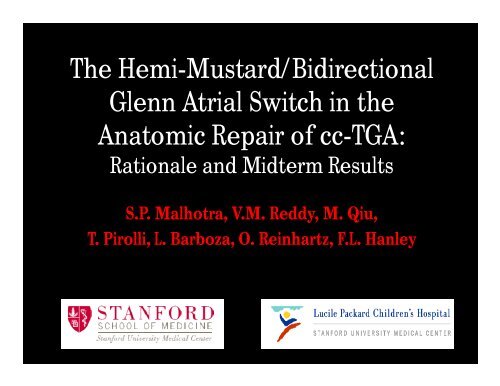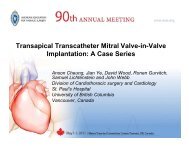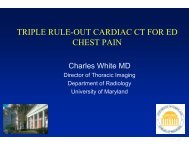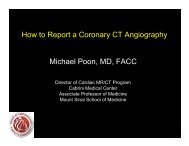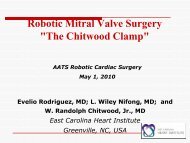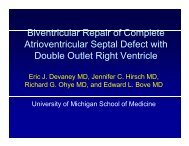The Hemi-Mustard/Bidirectional Glenn Atrial Switch in the Anatomic ...
The Hemi-Mustard/Bidirectional Glenn Atrial Switch in the Anatomic ...
The Hemi-Mustard/Bidirectional Glenn Atrial Switch in the Anatomic ...
You also want an ePaper? Increase the reach of your titles
YUMPU automatically turns print PDFs into web optimized ePapers that Google loves.
<strong>The</strong> <strong>Hemi</strong><strong>Mustard</strong>/<strong>Bidirectional</strong><br />
<strong>Glenn</strong> <strong>Atrial</strong> <strong>Switch</strong> <strong>in</strong> <strong>the</strong><br />
<strong>Anatomic</strong> Repair of ccTGA:<br />
Rationale and Midterm Results<br />
S.P. Malhotra, V.M. Reddy, M. Qiu,<br />
T. Pirolli, L. Barboza, O. Re<strong>in</strong>hartz, F.L. Hanley
No relationships to disclose
<strong>Anatomic</strong> repair of ccTGA<br />
• Support <strong>the</strong> systemic<br />
circulation with <strong>the</strong><br />
morphological left ventricle<br />
• Indication for <strong>in</strong>tervention<br />
– Decreased morphologic RV<br />
function<br />
– Progressive tricuspid<br />
regurgitation<br />
– VSD and/or PS, PA
OUR STRATEGY: Optimize outcomes of anatomic<br />
correction of ccTGA with <strong>the</strong> bidirectional <strong>Glenn</strong><br />
–RV Unload<strong>in</strong>g may<br />
•Lessen impact of RV dysfunction<br />
•Prolong life of RVPA conduit<br />
•Decrease tricuspid regurgitation<br />
–Simplify<strong>in</strong>g atrial baffle may<br />
•Reduce s<strong>in</strong>us node dysfunction and atrial dysrhythmias<br />
•Reduce systemic and pulmonary venous pathway<br />
obstruction<br />
•Be helpful with positional anomalies such as situs solitus<br />
with dextrocardia, mesocardia and situs <strong>in</strong>versus
Patients<br />
•48 patients between Jan 1993 to Sept 2009<br />
•Rastelliatrial switch (RAS): 25<br />
–Pulmonary atresia: 22 (4 with PA/MAPCAs)<br />
–Severe subpulmonary stenosis: 3<br />
•Arterialatrial switch (AAS): 23<br />
–PAB required: 17<br />
–PAB tightened: 8
<strong>Anatomic</strong> Details<br />
• Morphology<br />
–Positional anomalies <strong>in</strong> 35% (17/48)<br />
–[S,L,L] 42<br />
•Dextrocardia: 10<br />
•Mesocardia: 1<br />
–[I,D,D] 6<br />
• VSD: 40<br />
• Congenital HB: 4<br />
• Tricuspid valve anomalies: 22<br />
– Moderate or greater TR: 20<br />
– Ebste<strong>in</strong>oid valve: 10
Age distribution<br />
20<br />
18<br />
16<br />
14<br />
12<br />
10<br />
8<br />
6<br />
4<br />
2<br />
0<br />
< 1 yr 15 yr 510 yr 1015 yr > 15 yr<br />
•Median age 3.0 years<br />
•Range 3.9 months to 24.0 years
PreDSO Procedures<br />
Arterialatrial group<br />
Rastelliatrial group<br />
Pulmonary artery band 17 Modified BlalockTaussig Shunt 17<br />
PA Band tighten<strong>in</strong>g 8 Second Modified BlalockTaussig Shunt 5<br />
<strong>Bidirectional</strong> <strong>Glenn</strong> 2<br />
VSD repair 1<br />
Aortopulmonary w<strong>in</strong>dow prior to<br />
unifocalization<br />
Unifocalization of MAPCAs to central<br />
shunt<br />
2<br />
4<br />
Pacemaker implantation 3 <strong>Bidirectional</strong> <strong>Glenn</strong> 5<br />
Pacemaker implantation 1
Arterial<strong>Atrial</strong> <strong>Switch</strong> (AAS)<br />
Rastelli<strong>Atrial</strong> <strong>Switch</strong> (RAS)<br />
<strong>The</strong> “<strong>Hemi</strong><strong>Mustard</strong>” patch is always a simple circle, which<br />
bends appropriately around <strong>the</strong> TV annulus and IVC orifice
<strong>Hemi</strong><strong>Mustard</strong> <strong>Atrial</strong> <strong>Switch</strong><br />
•Performed <strong>in</strong> 33/48 (70%) patients<br />
•Conventional atrial baffle performed <strong>in</strong> 15<br />
–Elevated PVR— 5 cases<br />
–<strong>Anatomic</strong> considerations (LSVC to coronary s<strong>in</strong>us)2 pts<br />
–Surgeon preference— 8 pts (6 performed <strong>in</strong> <strong>the</strong> early<br />
experience)
Outcomes<br />
•Hospital mortality: 2.1% (1/48)<br />
•No late deaths<br />
•Postoperative ECMO support required <strong>in</strong> 2<br />
patients<br />
•Postoperative heart block: 21% (10/48)
Midterm results<br />
100% complete followup<br />
•Median followup 4.9 y, range 7 m 16 y<br />
•Biventricular function preserved <strong>in</strong> 87% of<br />
survivors<br />
–LV dysfunction:<br />
moderate— 4 (2 AAS)<br />
severe— 2<br />
(2 AAS)<br />
•NYHA functional class I <strong>in</strong> 43/47<br />
•All acyanotic<br />
•None have required cardiac transplantation
<strong>Hemi</strong><strong>Mustard</strong> results<br />
• No baffle obstruction (0/33)<br />
– Senn<strong>in</strong>g/<strong>Mustard</strong> experience: 515% 1,2<br />
• No s<strong>in</strong>us node dysfunction (0/33)<br />
– Senn<strong>in</strong>g/<strong>Mustard</strong> experience 3546% 3,4<br />
• 1 atrial tachyarrhythmia req ablation (1/33)<br />
– Senn<strong>in</strong>g/<strong>Mustard</strong> experience 815% 3,4<br />
• 2 BDG complications (Both age < 4 mo)<br />
– takedown due to circular shunt<br />
– neurologic complicationchoreoa<strong>the</strong>tosis<br />
1<br />
Helb<strong>in</strong>g, et al. J Thorac Cardiovasc Surg. 1994;108:36371.<br />
2<br />
Williams, et al. J Thorac Cardiovasc Surg. 1988;95:71723.<br />
3<br />
Fl<strong>in</strong>n, et al. N Engl J Med. 1984;310:163542.<br />
4<br />
Dos, et al. Heart. 2005;91:6526.
Outcomes: TR<br />
p=0.00004<br />
•TR grade decreased from 2.2 ± 1.0 to 1.3 ± 0.5<br />
•PostDS TR was not affected if BDG used
Outcomes: Reoperation<br />
• AAShigher earlier need for reoperation<br />
• RASlate reoperation due to RV to PA<br />
conduit replacement
Arterialatrial switch outcomes<br />
• Coronary complications: 2/23<br />
– Reop LeCompte/LCA release performed<br />
– Severe proximal RCA stenosis<br />
• NeoAortic <strong>in</strong>sufficiency: 2/23<br />
– AVR required <strong>in</strong> one patient<br />
– Both had PAB<br />
30<br />
25<br />
• At higher risk for decreased<br />
NYHA functional status<br />
compared to Rastelli group<br />
(p=0.013)<br />
20<br />
15<br />
10<br />
5<br />
0<br />
RAS<br />
AAS<br />
IV<br />
III<br />
II<br />
I
Rastelliatrial switch outcomes:<br />
RVOT revision<br />
• <strong>Hemi</strong><strong>Mustard</strong> group: 100% 10yr freedom from RVOT<br />
<strong>in</strong>tervention<br />
• Conventional atrial switch: 75% 5yr and 50% 10yr<br />
• <strong>Hemi</strong><strong>Mustard</strong> lower risk of RVOT re<strong>in</strong>tervention (p=0.019)
Conclusions<br />
• <strong>The</strong> double switch with <strong>the</strong> BDG can be performed<br />
with low morbidity and mortality<br />
• <strong>Hemi</strong><strong>Mustard</strong> should be avoided <strong>in</strong> <strong>the</strong> youngest<br />
patients that are at high risk for elevated PVR<br />
• Advantages of <strong>the</strong> <strong>Hemi</strong><strong>Mustard</strong>:<br />
–Decreases volume across RVOT and prolongs life<br />
of RV to PA conduit<br />
–Baffle complications m<strong>in</strong>imized<br />
–S<strong>in</strong>us node dysfunction m<strong>in</strong>imized<br />
–Unloads <strong>the</strong> fail<strong>in</strong>g right ventricle<br />
–Simplifies <strong>the</strong> atrial baffle technique


